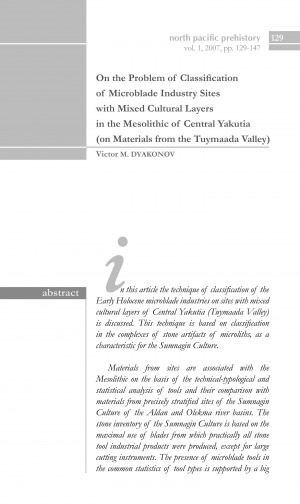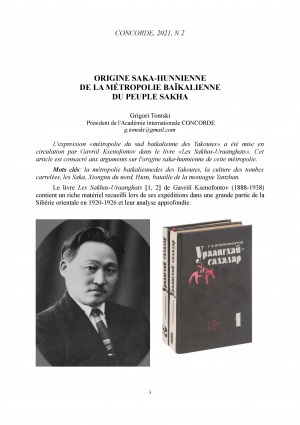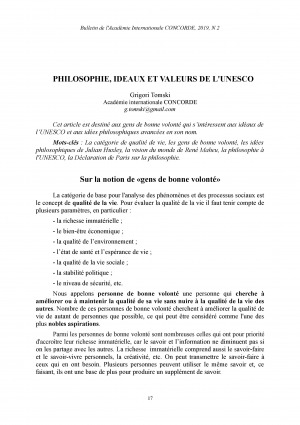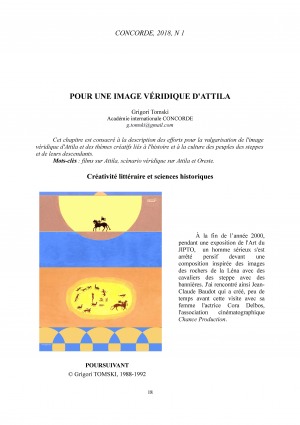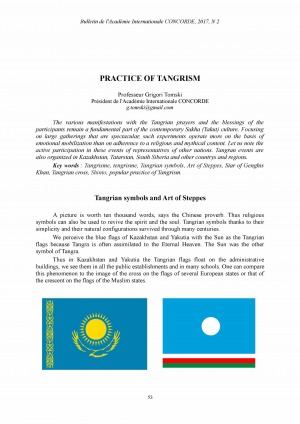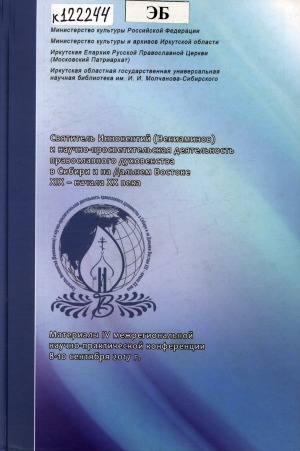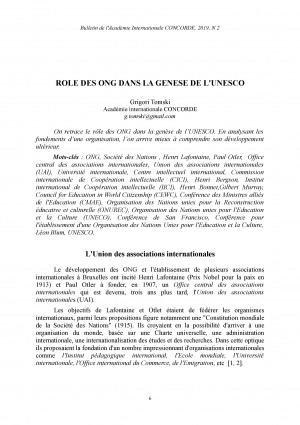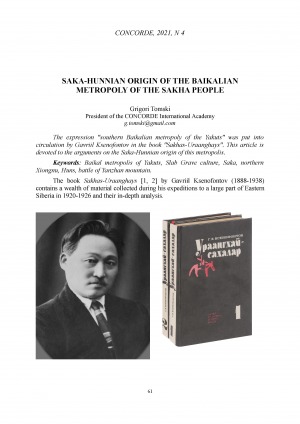Количество страниц: 19 с.
Работа посвящена проблеме изучения мезолита в Центральной Якутии. Здесь было известно небольшое количество стоянок сумнагинской культуры, характеризующихся смешанными культурными комплексами, и датированных этим временем лишь по аналогиям инвентаря. В работе предложена методика определения раннеголоценовых комплексов в смешанных культурных слоях, основанная на выделении в общих комплексах каменного инвентаря микролитов, в большей степени характерных для сумнагинской культуры. Проведённый анализ позволил выделить сумнагинский культурный комплекс на 11 памятниках Туймаады. На ещё около 25 памятниках, где обнаружены микропластинчатые индустрии, при расширении работ, может подтвердиться предположение о наличии в культурных слоях мезолитического каменного инвентаря
Dyakonov, V. M. On the Problem of Classification of Microblade Industry Sites with Mixed Cultural Layers in the Mesolithic of Central Yakutia (on Materials from the Tuymaada Valley) / Victor M. Dyakonov // North Pacific Prehistory : archaeological studies journal. — 2007. — Vol. 1. — P. 129-147.
Количество страниц: 14 с.
Tomski, G. V. Origine saka-hunnienne de la métropolie baïkalienne du peuple sakha / Tomski Grigori ; Académie internationale CONCORDE // Concorde. – 2021. – N 2. – С. 3-16.
Количество страниц: 14 с.
- Томский Григорий Васильевич > Международная деятельность,
- Общий отдел > Общие вопросы науки и культуры,
- Общественные науки. Образование > Право. Юридические науки > Международное право,
- НАУКА ЯКУТИИ > ОБЩИЙ ОТДЕЛ > Общие вопросы науки и культуры,
- НАУКА ЯКУТИИ > ОБЩЕСТВЕННЫЕ НАУКИ > Право. Юридические науки.
Tomski, G. V. Philosophie, ideaux et valeurs de l'UNESCO / Grigori Tomski // Bulletin de l’Académie Internationale CONCORDE. - 2019. – N 2. – С. 17-29.
Количество страниц: 28 с.
- Томский Григорий Васильевич > Произведения,
- Краеведение. Археология. География. Биографии. История > Историческая наука. Историография > Всеобщая история. История отдельных стран и народов,
- Искусство. Фотография. Музыка. Игры. Спорт > Развлечения. Зрелища. Игры,
- НАУКА ЯКУТИИ > КРАЕВЕДЕНИЕ. ГЕОГРАФИЯ. БИОГРАФИИ. ИСТОРИЯ > Историческая наука. Историография > Всеобщая история,
- НАУКА ЯКУТИИ > ИСКУССТВО. ФОТОГРАФИЯ. МУЗЫКА. ИГРЫ. СПОРТ > Развлечения. Зрелища. Игры.
Tomski, G. V. Pour une image véridique d'Attila / Tomski G. ; Académie Internationale CONCORDE // Concorde. – 2018. – N 1. – С. 18-45.
Количество страниц: 10 с.
Различные тангрийские молитвы и благословения остаются фундаментальной частью современной культуры саха (якутов). Они проводятся при больших и значительных событиях, такая практика основана больше на эмоциональной мобилизации, чем на приверженности религиозному и мифическому содержанию. Отметим активное участие в этих мероприятиях представителей других народов. Мероприятия Тангран также проводятся в Казахстане, Татарстане, Южной Сибири и других странах и регионах.
Tomski, G. V. Practice of Tangrism / Grigori Tomski // Bulletin de l’Académie Internationale CONCORDE. - 2017. – N 2. – С. 53-62.
Количество страниц: 17 с.
Батагайка (или Батагайский кратер) на севере Якутии, обнажает замечательную стратиграфическую последовательность мерзлотных отложений толщиной ~50-80 м. Чтобы определить их потенциал для ответа на ключевые вопросы о четвертичных экологических и климатических мы провели рекогносцировочное исследование их криостратиграфии и палеоэкологии, подкрепленное четырех дальномерных 14С-возрастов. Последовательность включает два ледниковых комплекса, разделенных блоком мелкого песка, содержащего узкие сингенетические ледяные клинья и многочисленные палеосоли. В целом, последовательность развивалась по мере сингенетического роста вечной мерзлоты через эоловый песчаный лист, развивающийся на склоне холма. Древесные остатки встречаются в двух лесных слоях, каждый из которых связан с красноцветным горизонтом выветривания. Нижний слой содержит большое количество пыльцы Larix (>20%), а также небольшое количество Picea и Pinus pumila, и его относят к межледниковым условиям. В пыльце из вышележащей последовательности преобладают травянистые таксоны (~70%-80%), отнесенные к открытому тундровому ландшафту в межстадиальных климатических условиях. Из трех рассмотренных гипотетических возрастных схем, мы предварительно относим большую часть последовательности Батагайка к морскому кислородно-изотопному этапу (МИЭ 3).Верхний и нижний лесные слои могут представлять собой оптимум середины МИЭ 3 и МИЭ 5, соответственно, хотя мы не можем сбрасывать со счетов альтернативные атрибуции МИЭ 5 и 7
Preliminary paleoenvironmental analysis of permafrost deposits at Batagaika megaslump, Yana Uplands, northeast Siberia / Julian B. Murton, Mary E. Edwards, Anatoly V. Lozhkin [etc.] // Quaternary Research . - 2017. - Volume 87(issue 2). - P. 314-330. URL: https://www.cambridge.org/core/journals/quaternary-research/article/preliminary-paleoenvironmental-analysis-of-permafrost-deposits-at-batagaika-megaslump-yana-uplands-northeast-siberia/6E1CDD9631CF354F08444B50DD2EBE4D (дата обращения: 29.10.2024).
DOI: 10.1017/qua.2016.15
Источник: SHS Web of Conferences. - 2022, Т. 134.
Количество страниц: 7 с.
Целью данного исследования является изучение звукоиздающих подвесок на шаманском костюме эвенков, якутов и нганасан в единстве шаманского ритуального комплекса и ритуальных музыкальных традиций. Шаманские подвески интерпретируются как особый текст культуры, отражение геокультурных представлений народов Арктики. Статья основана на материалах полевых исследований, проведённых авторами на Таймыре в 1989–1990 годах, в Оленёкском эвенкийском национальном округе Якутии в 2014 году, а также на научных публикациях. Звуковой мир шаманского ритуала — это сложная звуковая картина, которая формируется при использовании вокальных, вербальных, вокально-речевых, сигнальных, инструментальных типов интонации. Движения шамана сопровождаются звуком сталкивающихся подвесок на костюме шамана и его составляющих (повязке, обуви, перчатках).
Звукоиздающие подвески были описаны этнографами и музыковедами, но не рассматривались в связи с геокультурными исследованиями. Металлические подвески на костюме шамана обозначают священные пространственные модели Вселенной (образы небесных тел — солнца, луны, звёзд), мифологические пространства Верхнего, Среднего и Нижнего миров, населённые духами-помощниками шамана — птицами, животными, антропоморфными существами, символизируют части человеческого тела и т. д. Перспективы изучения подвесок на костюме шамана как символического воплощения ландшафта заключаются в более полном описании и обобщении всех известных материалов, включая анализ костюмов шаманов из этнографических музейных коллекций.
Reflection of Arctic geocultures in the sounding attributes of the shaman costumes of Sakha, Evenks and Nganasans / Oksana Dobzanskaya, Vera Nikiforova, Varvara Dyakonova ; Arctic State Institute of Culture and Arts // SHS Web of Conferences. - 2022, Т. 134. - С. 1-7
Количество страниц: 220 с.
- Религия. Теология,
- Краеведение. Археология. География. Биографии. История > Историческая наука. Историография > Всеобщая история. История отдельных стран и народов,
- НАУКА ЯКУТИИ > РЕЛИГИЯ. ТЕОЛОГИЯ,
- НАУКА ЯКУТИИ > КРАЕВЕДЕНИЕ. ГЕОГРАФИЯ. БИОГРАФИИ. ИСТОРИЯ > Историческая наука. Историография > Всеобщая история.
Есть много литературных произведений об Аттиле и Чингисхане, написанных европейцами, американскими и российскими авторами. Один из их главных недостатков - вопиющее незнание религии этих великих исторических личностей. Мои работы про Аттилу, посвящены разбору великих исторических загадок: - Отношения Аттилы и Аэция; - Загадки каталаунских полей; - Тайны встречи Аттилы и Папы Льва в Италии. Форма литературных произведений позволяет не только логически анализировать исторические события, а также создать психологические портреты участников этих событий для лучшего понимания глубинной мотивации их действий.
Tomski, G. V. Religion of Attila / Grigori Tomski // Bulletin de l’Académie Internationale CONCORDE. - 2017. – N 2. – С. 3-52.
Количество страниц: 12 с.
Tomski, G. V. Role des ong dans la genese de l'UNESCO / Grigori Tomski // Bulletin de l’Académie Internationale CONCORDE. - 2019. – N 2. – С. 6-16.
Количество страниц: 14 с.
- Общественные науки. Образование > Этнография. Обычаи. Жизнь народа. Нравы,
- Краеведение. Археология. География. Биографии. История > Историческая наука. Историография > Всеобщая история. История отдельных стран и народов,
- НАУКА ЯКУТИИ > КРАЕВЕДЕНИЕ. ГЕОГРАФИЯ. БИОГРАФИИ. ИСТОРИЯ > Историческая наука. Историография > Всеобщая история,
- НАУКА ЯКУТИИ > ОБЩЕСТВЕННЫЕ НАУКИ > Этнография. Обычаи. Жизнь народа. Нравы.
Tomski, G. V. Saka-hunnian origin of the baikalian metropoly of the sakha people / Tomski Grigori ; Académie internationale CONCORDE // Concorde. – 2021. – N 4. – С. 61-74.
